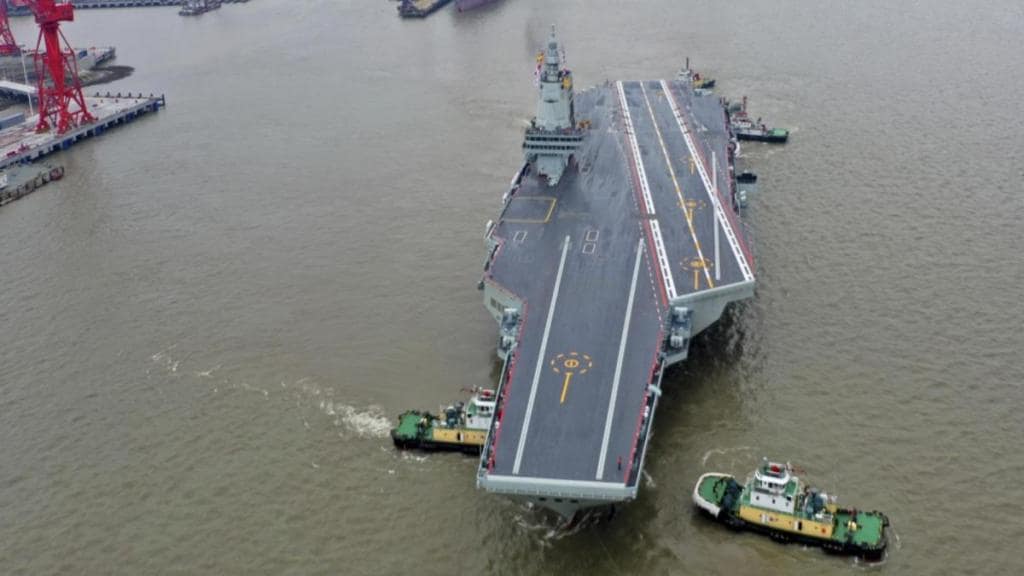China’s ambitions to solidify its position as a dominant maritime force are taking a giant leap forward with the unveiling of its third aircraft carrier, the Fujian. Standing as a testament to China’s relentless pursuit of naval supremacy, the Fujian has garnered attention from naval experts worldwide, who have dubbed it the epitome of a “super-carrier.”
Embarking on its maiden voyage for sea trials on May 1, the Fujian represents a significant milestone in China’s quest to assert its dominance in the Asia-Pacific region.
Unlike China’s previous two carriers, the Liaoning and Shandong, which employ ski-jump take-off techniques, the Fujian’s electromagnetic catapults (EMALS) enable more efficient launches, allowing jets to carry heavier payloads and reducing the time between successive launches.
China’s latest carrier is also possibly the world’s first conventionally powered carrier with an Electromagnetic Catapult (CATOBAR) Launch System (EMALS). Whereas almost all other carriers in service today are nuclear powered, with EMALS being used by the US Navy and the French Navy.
The Fujian, boasting a weight of 80,000 tonnes, is comparable in size to its US counterparts and even surpasses carriers manufactured by other prominent naval powers such as the UK, France, India, and Japan. Its significance lies not only in its size but also in the technological advancements it incorporates.
According to reports from the Chinese Communist Party-owned Xinhua News Agency, the Fujian embarked on its inaugural test voyage from Jiangnan Shipyard in Shanghai, setting sail for a week-long sea trial in the East China Sea. These trials aim to assess the reliability and stability of the carrier’s propulsion and power systems.
Named after the Fujian province, this state-of-the-art carrier is equipped with groundbreaking technology. Measuring around 316 meters in length and boasting a deck width of 76 meters, the Fujian features three catapult runways, enabling rapid deployment of fighter jets. This strategic design ensures operational continuity even in the event of system failures, an evidence of China’s thorough planning and preparation.
What is onboard?
Boosted with advanced indigenous surveillance and self-defence systems, including the HQ-10 short-range surface-to-air missile system and H-P11 autocannon, the Fujian is set for combat readiness. Deploying state-of-the-art aircraft such as the New J-15, fifth-generation stealth fighter J-35, and KJ-600 Airborne Early Warning (AEW) aircraft, the Fujian underscores China’s commitment to modernizing its naval arsenal.
While the Fujian undergoes rigorous sea trials over the next two years to ensure seamless integration of its complex technologies, China’s future plans for additional carriers remain on the horizon.
The deployment of the Fujian signifies China’s continued efforts to strengthen its maritime capabilities and extend its influence beyond its immediate periphery. A report by the US Department of Defense highlights the Fujian’s potential to enhance the striking power of the Chinese Navy’s carrier battle groups in regions beyond China’s immediate vicinity.
India Watching
As China expands its maritime capabilities, the challenge for neighbouring India intensifies. With two aircraft carriers currently in service and plans for a third underway, India aims to counter China’s growing influence in the Indian Ocean region.
In the face of escalating tensions along the Line of Actual Control (LAC) and beyond, India remains vigilant, closely monitoring China’s maritime advancements.
With the potential to alter the balance of power in the Indo-Pacific, the rise of the Fujian signifies a new chapter in naval warfare, one where China emerges as a formidable challenger to traditional maritime powers. As the world watches China’s rise, the implications for regional security and stability loom large, shaping the dynamics of naval strategy for years to come.


